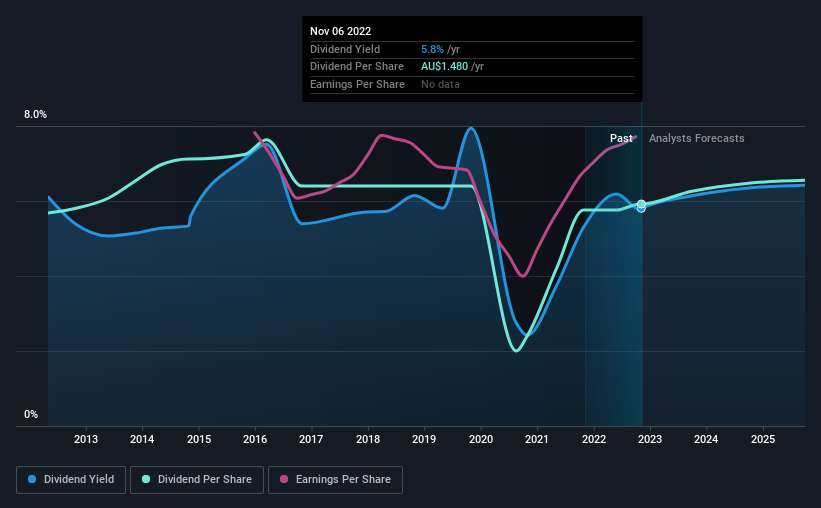Australia and New Zealand Banking Group (ASX:ANZ) Is Increasing Its Dividend To A$0.74

Australia and New Zealand Banking Group Limited's (ASX:ANZ) dividend will be increasing from last year's payment of the same period to A$0.74 on 15th of December. This takes the dividend yield to 5.8%, which shareholders will be pleased with.
Our analysis indicates that ANZ is potentially undervalued!
Australia and New Zealand Banking Group's Dividend Forecasted To Be Well Covered By Earnings
We like to see robust dividend yields, but that doesn't matter if the payment isn't sustainable.
Australia and New Zealand Banking Group has a long history of paying out dividends, with its current track record at a minimum of 10 years. Taking data from its last earnings report, calculating for the company's payout ratio shows 58%, which means that Australia and New Zealand Banking Group would be able to pay its last dividend without pressure on the balance sheet.
Over the next 3 years, EPS is forecast to fall by 2.7%. Despite that, analysts estimate the future payout ratio could be 68% over the same time period, which is in a pretty comfortable range.

Dividend Volatility
Although the company has a long dividend history, it has been cut at least once in the last 10 years. The annual payment during the last 10 years was A$1.42 in 2012, and the most recent fiscal year payment was A$1.48. Dividend payments have grown at less than 1% a year over this period. Modest growth in the dividend is good to see, but we think this is offset by historical cuts to the payments. It is hard to live on a dividend income if the company's earnings are not consistent.
Dividend Growth May Be Hard To Achieve
With a relatively unstable dividend, it's even more important to evaluate if earnings per share is growing, which could point to a growing dividend in the future. Australia and New Zealand Banking Group hasn't seen much change in its earnings per share over the last five years. The company has been growing at a pretty soft 1.9% per annum, and is paying out quite a lot of its earnings to shareholders. This isn't bad in itself, but unless earnings growth pick up we wouldn't expect dividends to grow either.
Our Thoughts On Australia and New Zealand Banking Group's Dividend
Overall, this is a reasonable dividend, and it being raised is an added bonus. While the payout ratios are a good sign, we are less enthusiastic about the company's dividend record. The dividend looks okay, but there have been some issues in the past, so we would be a little bit cautious.
Market movements attest to how highly valued a consistent dividend policy is compared to one which is more unpredictable. Still, investors need to consider a host of other factors, apart from dividend payments, when analysing a company. Taking the debate a bit further, we've identified 2 warning signs for Australia and New Zealand Banking Group that investors need to be conscious of moving forward. If you are a dividend investor, you might also want to look at our curated list of high yield dividend stocks.
New: Manage All Your Stock Portfolios in One Place
We've created the ultimate portfolio companion for stock investors, and it's free.
• Connect an unlimited number of Portfolios and see your total in one currency
• Be alerted to new Warning Signs or Risks via email or mobile
• Track the Fair Value of your stocks
Have feedback on this article? Concerned about the content? Get in touch with us directly. Alternatively, email editorial-team (at) simplywallst.com.
This article by Simply Wall St is general in nature. We provide commentary based on historical data and analyst forecasts only using an unbiased methodology and our articles are not intended to be financial advice. It does not constitute a recommendation to buy or sell any stock, and does not take account of your objectives, or your financial situation. We aim to bring you long-term focused analysis driven by fundamental data. Note that our analysis may not factor in the latest price-sensitive company announcements or qualitative material. Simply Wall St has no position in any stocks mentioned.
About ASX:ANZ
ANZ Group Holdings
Provides various banking and financial products and services to retail, individuals and business customers in Australia and internationally.
Flawless balance sheet average dividend payer.


